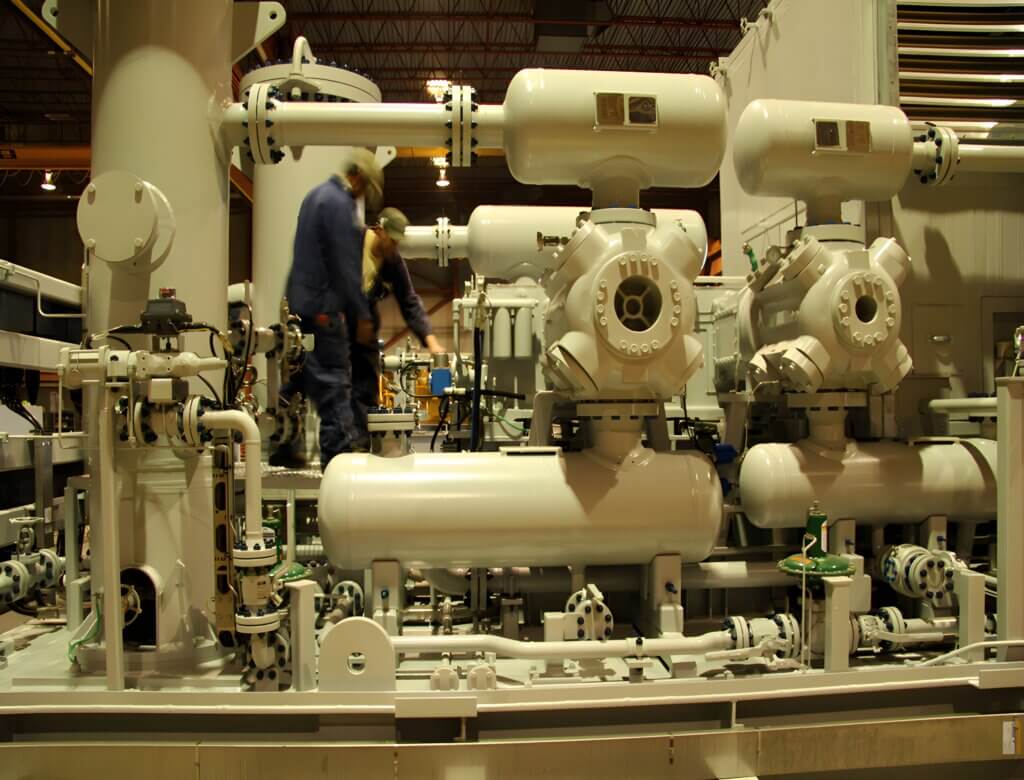API 618 Compressor Pulsation Studies
Pulsation and mechanical response studies conforming to API 618
Reciprocating compressors cause pressure pulsations in the flow downstream of the compressor. Depending on their amplitude and frequency, these pulsations could excite mechanic and acoustic resonance modes within the piping.
If an acoustic mode is excited then pressures exceeding the design pressure of the piping, or problems in downstream equipment, may result. If a mechanical resonance mode is excited, the piping is likely to vibrate, and fatigue failure and excessive loads on the supporting structure become a concern.
The industry standard design code API 618 provides guidelines for the permissible pulsation amplitudes caused by a reciprocating compressor. Dynaflow Research Group (DRG) is adept in using this design code to conduct pulsation and mechanical response studies.
Pulsation Studies
By conducting a pulsation study of the piping system or a compressor skid, DRG can determine if excessive pressure pulsations will occur in your system. Depending on the phase in the design process, the appropriate approach described in API 618 is used to ensure conformance up to the compressor exit flange or within the entire downstream piping system.
Should a system not conform to the API 618 and excessive pressure pulsations are to be expected, DRG always offers comprehensive recommendations for how to achieve conformance. This could, for instance, mean introducing compression dampeners or bottles on the compressor’s suction and/or discharge side.
When conducting a pulsation study, we make use of our own commercially available software package BOSpulse. BOSpulse has been specifically developed for conducting pulsation analyses and has the option to check for conformance with API 618 built-in.


Mechanical Response Analysis
Any structure or piping system will have a number of mechanical resonance (natural) frequencies. Identifying these natural frequencies is vital for ensuring that there is the necessary separation to the pulsation frequencies from the reciprocating compressor.
Using piping modelling software, DRG is able to conduct a mechanical response study to determine which of these resonance modes will be excited by the pressure pulsations and if the stresses could lead to a fatigue failure.
Our expertise in piping design means that we can propose practical and realizable solutions to remove any critical resonance modes and ensure that the system conforms to the applicable piping design code.
Solving Issues In The Field
Pulsation problems, such as excessive pipe vibrations or the rupture of a branch connection, can occur during operation. Usually, these occur within systems for which no pulsation analysis had been conducted. However, even if the relevant design codes were satisfied at the design stage, installation faults or unanticipated operating scenarios can lead to problems.
To solve problems in the field, DRG works closely with the on-site staff. Our experts will assess the extent of the problem and, if it is possible to replicate the vibrations, DRG can take measurements to determine their amplitude and frequency. The results of the inspection and any measurements are then used by DRG to identify the cause of the vibration and to propose a solution.

Case Study: Solving Pulsations In A Compressor Station
In this case, it was required to show that a new compressor station conformed to API 618. As the amplitudes of pressure pulsations were unknown at that point in the design phase, DRG used the API 618 limits as a worst-case scenario for a mechanical response study. DRG first built a model of the piping including structures using the piping stress software CAESAR II. To simulate the pulsations, unbalanced forces were applied to the piping model.
Using the dynamic module of CAESAR II, DRG identified a number of mechanical resonance modes that were being excited by pressure pulsations. To alleviate these issues and avoid a potential fatigue failure, modifications were required. By changing the pipe supporting functionalities within the station and increasing the stiffness of the supporting structure, DRG showed that it was possible to change the frequencies of the mechanical resonance modes, and thereby eliminate the fatigue problem.

